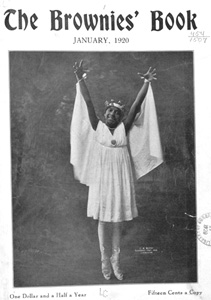The Brownies' Book

From the success of The Crisis’s annual children’s number emerged The Brownies’ Book, a monthly magazine specifically written for African American children. It was the first sustained effort to create a body of writing that exclusively addressed the needs of African American children. The magazine ran from January 1920 to December 1921 under the editorship of W. E. B. Du Bois, Augustus Granville Dill (who served as business manager) and Jessie Fauset (as literary editor in 1920 and managing editor in 1921). The Brownies’ Book was comprised of stories (folktales, fantasies, as well as more realistic stories), poems, games, articles on current events, and photographs of and letters from young readers. It celebrated African American identity, urged racial pride, and encouraged its young readers to aspire to positions of leadership within their communities.
The content of Du Bois’s Brownies’ Book showcased his opposition to the social philosophy espoused by Booker T. Washington and provided an alternative vision of the ideal education for African Americans. Rudine Sims Bishop notes that “Du Bois resolutely demanded excellence in education for Black children, including a strong foundation in reading, writing, and especially thinking” (Bishop 22). The Brownies’ Book was a way for Du Bois to help cultivate what he termed the Talented Tenth—the most able ten percent of African Americans who, equipped with a broad and liberal education, would serve as new leaders of the black community.
The Brownies’ Book was instrumental in promoting future African American children’s literature. It advertised and sold books for African American children that were not readily available in bookstores, including works by Benjamin Brawley, Paul Laurence Dunbar, and W. E. B. Du Bois (Wilson xxi). For example, The Brownies’ Book carried an advertisement for Elizabeth Ross Haynes’s Unsung Heroes , another significant contribution to the literature available to African American children.
The Brownies’ Book also provided a venue for young aspiring writers and helped to propel future careers in and beyond the field of children’s writing. Starting in 1925, Effie Lee Newsome, a poet and naturalist who had contributed to the magazine, wrote a regularly-featured children’s section entitled “The Little Page” for The Crisis. Later, she also published a volume of poetry for young children, Gladiola Garden. Though the bulk of Langston Hughes’ writing career was not addressed to a youth readership, Hughes is another notable example of a writer for whom The Brownies’ Book provided early inspiration and support. When he was eighteen, The Brownies’ Book published Hughes’s high school graduation photo and a letter he wrote to the editor. In 1921, the magazine became the first to publish Hughes’s poetry. In later issues, Hughes also contributed nonfiction pieces, a play, and a short story, all of which helped prepare Hughes in becoming perhaps the most recognized writer of the Harlem Renaissance.
Issues of The Brownies' Book
- The Brownies' Book, January 1920
- The Brownies' Book, February 1920
- The Brownies' Book, March 1920
- The Brownies' Book, April 1920
- The Brownies' Book, May 1920
- The Brownies' Book, July 1920
- The Brownies' Book, August 1920
- The Brownies' Book, September 1920
- The Brownies' Book, October 1920
- The Brownies' Book, November 1920
- The Brownies' Book, December 1920
- The Brownies' Book, January 1921
- The Brownies' Book, February 1921
- The Brownies' Book, March 1921
- The Brownies' Book, April 1921
- The Brownies' Book, May 1921
- The Brownies' Book, June 1921
- The Brownies' Book, July 1921
- The Brownies' Book, August 1921
- The Brownies' Book, September 1921
- The Brownies' Book, October 1921
- The Brownies' Book, November 1921
Works Cited
- Bishop, Rudine S. Free Within Ourselves: The Development of African American Children's Literature. Westport, Conn: Greenwood Press, 2007. Print.
- Wilson, Francille Rusan. Introduction. Unsung Heroes; The Black Boy of Atlanta; Negroes in Domestic Service in the United States. By Elizabeth Ross Haynes. New York: G.K. Hall, 1997. xv-xxxvii. Print.